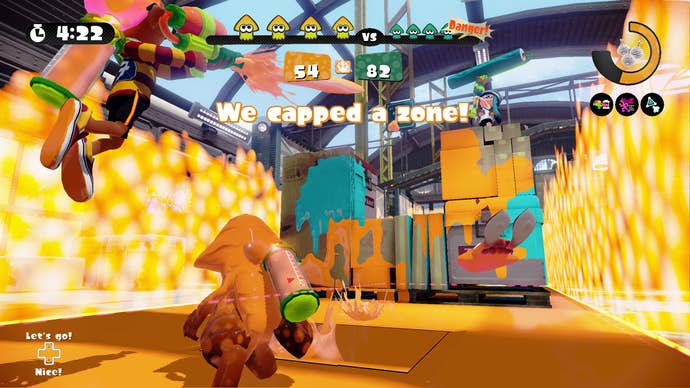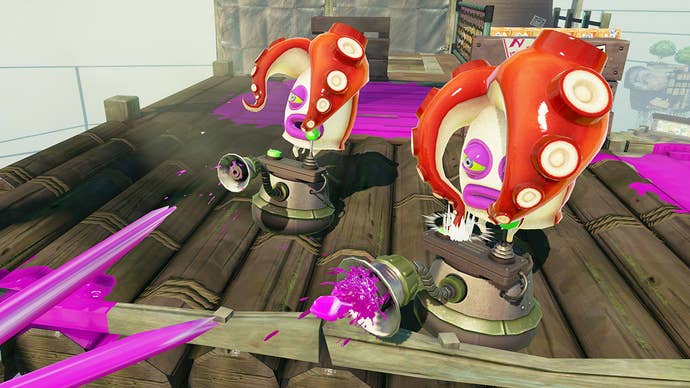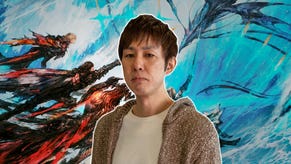Hisashi Nogami Interview: "Splatoon allows for adaptive playstyles"
Splatoon's producer talks about the origins of the game, player communications, and offers some advice to Splatoon beginners.
This article first appeared on USgamer, a partner publication of VG247. Some content, such as this article, has been migrated to VG247 for posterity after USgamer's closure - but it has not been edited or further vetted by the VG247 team.
At a recent Nintendo event, I got the chance to sit down with Hisashi Nogami, producer of Splatoon and talk to him about the upcoming Wii U shooter."
What are the origins of Splatoon, and how was it conceptualized?
"It started from the concept of not wanting to make a game was too wrapped up in franchises that Nintendo has dealt with before. It's something that could be on its own. After making that initial decision, we started experimenting with a variety of prototypes and a variety of ideas."

"The first prototype that got off the ground was made by Mr Sato, a member of the team who's worked on prior games as a graphics programmer. That prototype included the basic features of Splatoon in that it was a game that players were on teams, competing against one another, and you shot ink and covered the ground. The team that covered the most territory would win. When you sprayed ink on the ground, it was viewable on a map in realtime. But in this prototype, when you viewed the map from above because your character was initially the same color as the ink you're shooting, you couldn't see them. This was a bonus feature – when you're in your own ink the enemy can't see you."
"That initial prototype started with characters that weren't actually characters, they were just blocks. You'd have a white block on one team and a black block on the other, and there wasn't even that much of a detailed 3D element to the game. But from that point onwards, a variety of different features were added to the game to make it more of a polished Nintendo-style experience, and the characters were built out. That has led to the game that Splatoon is today."
"Another way of saying this is that the game didn't really begin from a particular visual look, but instead started from function. What kind of features and functionality do we want to give players? That was the starting off point for Splatoon."
Was Splatoon influenced by any particular games?
"As members of the Splatoon team, we are actually also gamers and we play a variety of games and feel like we have a good understanding of the types of elements that are popular in games, or trends that are happening because we play a lot of games ourselves."

"We are also game designers so we can't help that when we do play games we're going to think "this element is particularly fun" or "this element isn't that great". We can't help but bring that perspective to the games we play. So while it is definitely true that the experiences we have playing other games are going to have some degree of entering into our thoughts about the game we're making, we can't go so far as to say that, "Oh, let's bring this particular thing we enjoy from this other game, and make sure that's in Splatoon." Or, "We didn't like this, let's make sure that's not in Splatoon." There's not that direct a connection."
Splatoon features a plaza that is the main focus of the game. What was the thinking behind its design?
"The plaza is a hub area of sorts – a jumping off point for all the features and modes in the game. Players start out by being dropped into this Plaza, and from there they can choose to jump into online play or explore the single-player mode, or do a bit of shopping to outfit themselves for online play."
"You're not alone in the plaza. The other squids you see in the plaza are not just simply NPCs, but actually represent other players that are participating in Splatoon and you can view a bit of their information as well."
"The goal with populating the plaza in this way is to allow you to bump into players that you either maybe haven't met before, or someone you just faced off against in battle. But because you can check out their gear they are wearing you can get that kind of information and say "maybe I'm going to emulate his or her style of play". That was the thought behind the way we populate the plaza."
"It's not that we're trying to force that on every player to say "okay, to get all your information you really have to check each player carefully," but just more we wanted it to be a natural element of the game. Another way you could see that there is a bunch of different playstyles in this game by looking at what they're using, and looking at what they're wearing."
On the face of it, Splatoon looks like a typically cute Nintendo game, but underneath it's a quite sophisticated tactical shooter. What kind of player is the game aimed at?
"One of the main aims the team had in making Splatoon was to make it a game that appealed and was fun to play to a really wide variety of players. That includes players that were familiar with the shooter genre, and to also widen the scope of players who haven't had as much experience with shooters and make sure they can also pick up the game and enjoy it."

"That said, it wasn't that we set out to make a game for people who haven't played shooters before. That wasn't the aim. But to have that wide scope while also making a game that would be satisfying for players who are used to ranking up and rising up levels and unlocking new types of things."
"I feel personally that in their play experiences, the development team have observed that people will really put a lot of thought into how they are playing. So, maybe before I played on the offensive, and this time I'll play more thoughtfully and hang back and cover the place in ink. And in that way, that Splatoon allows for adaptive playstyles, the game has elements of a sport, and with all the thought we’ve put into the things we've mentioned so far, I think it will appeal to e-Sports players."
"That's one of the reasons why we've included all the variety of weapons and gear that you'll find in the game. To make a concrete element a more advanced player can sink their teeth into and enjoy."
"The combinations of weapons and gear supports lots of different playstyles – but it's accessible to the folks who just want to jump in and run around."
One element that seems to be important in team play is voice communication, but Splatoon doesn't have that feature. How does Mr Nogami think players will communicate in-game if they are serious about playing as a team.
"In terms of communication in games in general, there are two main types: communication about strategy, and communication about feelings you have while playing at that moment. When that point is applied to this game, one interesting aspect of Splatoon is that the actions you take shooting ink can immediately be seen in the stage you're playing by yourself and other players, and conversely when you see the actions other players are taking shooting ink, it's something you can interpret immediately and then base your next actions on that and judging what that means. That's an important part of the gameplay in Splatoon."
"In designing the game, we paid special attention to allowing the gameplay to cover a lot of ground for that kind of strategic communication. However we definitely understand the importance players put on that other type of communication that's more feelings-based."

"And so because we understand that desire for players to have that kind of emotional communication, we can imagine players using some way or another to achieve that extra layer of communication while playing the game."
The weapons in the game support a variety of different playstyles. Which one does Mr Nogami favor – and what is his personal playstyle?
"When it comes to the type of weapon I prefer, that's been changing a lot recently. There are a lot of people on the Splatoon development staff that are really good at shooting games, and my main goal in terms of playstyle is to avoid running into them. To sum up my playstyle – don't die. Don't get defeated."
"Recently the weapon I've been using is the .52 Gal. That's been my recent favorite, so I can cover the ground as much as possible."
What advice would Mr Nogami give to people playing online multiplayer Splatoon for the first time?
"There are a lot of players that are more skilled than I am, so I feel a bit sheepish about answering this myself, but my advice to players starting out is because the goal of turf wars is the team that covers the most ground with ink wins – so stay alive and continue to cover the ground effectively with ink. That should be your main goal in turf wars."

"But of course in going about your business you're going to run into other players and so you do need to develop enough skill that you can fight back against them and spray them down so that you don't just immediately get taken down whenever you run into someone."
"One good way to think about it would be "what can I do, how can I act in a way that would best contribute to my team," and to keep that in your mind constantly while you play. For example, if you notice someone is focused on taking out other players, you can sneak behind them and cover their territory with ink, and that'll be a more effective way to play."






_ddwYK80.png?width=291&height=164&fit=crop&quality=80&format=jpg&auto=webp)

